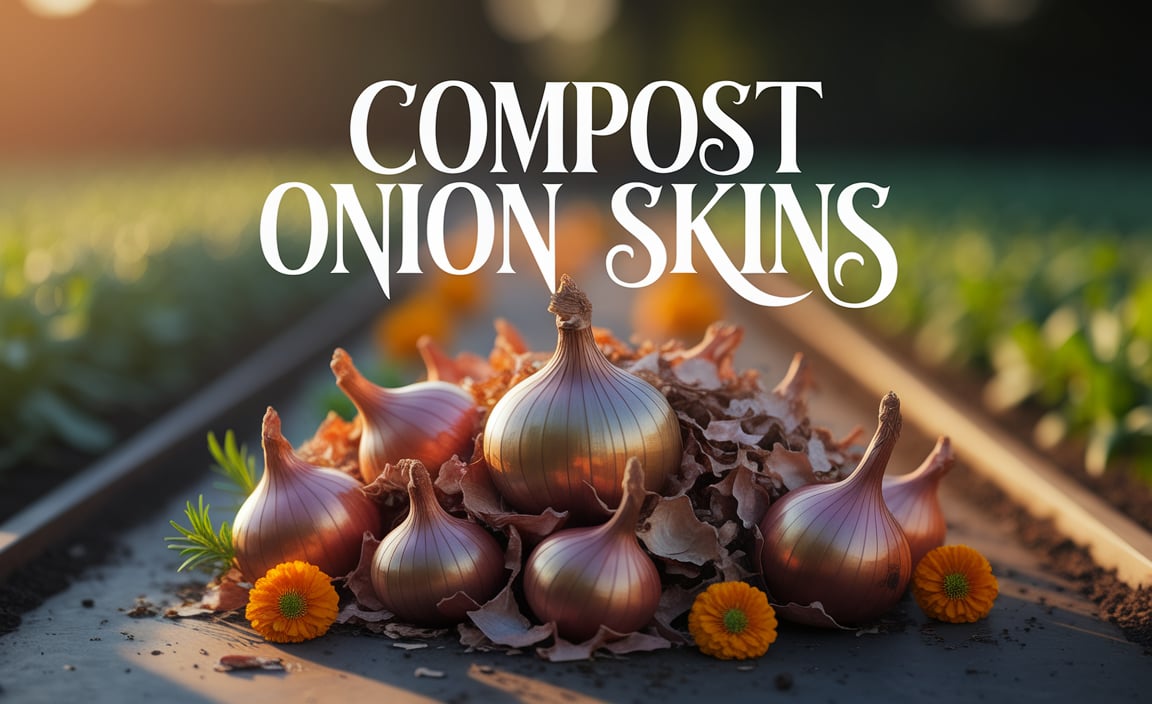Seeing little white wrigglers in your compost bin can be a bit startling! If your compost has maggots, don’t panic. It’s a common situation for many composters, and usually a sign that your compost is actively breaking down. In fact, maggots are nature’s little cleanup crew. But if you want to manage them better, you’ve come to the right place. We’ll break down exactly why they show up and give you simple, effective ways to handle them, so you can get back to healthy, happy composting.
Why Are There Maggots in My Compost?
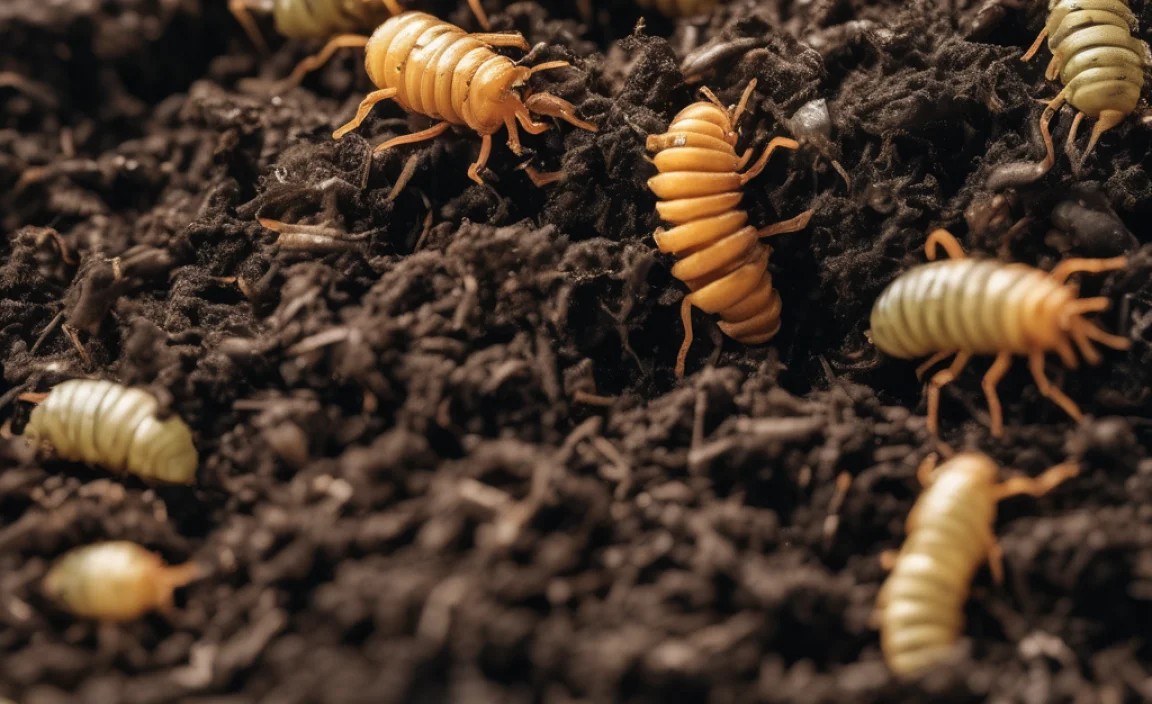
Before we fix the maggot situation, let’s understand why they’re there in the first place. Maggots are the larval stage of flies, most commonly the housefly or fruit fly. These flies are attracted to the moist, nutrient-rich organic materials in your compost bin. They lay their eggs, and voilà – maggots! It’s a natural part of decomposition.
Think of it like this: your compost pile is a buffet for flies. They see it as a prime nursery for their young. While a small number of maggots can actually speed up the composting process by breaking down food scraps faster, a large infestation can sometimes lead to unpleasant odors or attract more pests. The key is balance and understanding what attracts them.
Common Culprits for Maggot Attraction
- Food Scraps: Especially fruit and vegetable peels, leftover cooked food, and meat/dairy (though many avid composters avoid these for good reason).
- Moisture: A compost pile that’s too wet can become a breeding ground.
- Lack of Carbon-Rich Materials: Not enough “browns” (like dry leaves or cardboard) means the pile can get too wet and mushy, making it more inviting.
- Poor Aeration: If air can’t circulate, things can get stagnant and attract flies.
- Exposed Food Waste: When food scraps are left uncovered on top of the pile, they are an easy target for flies.
Is Having Maggots in Compost Bad?
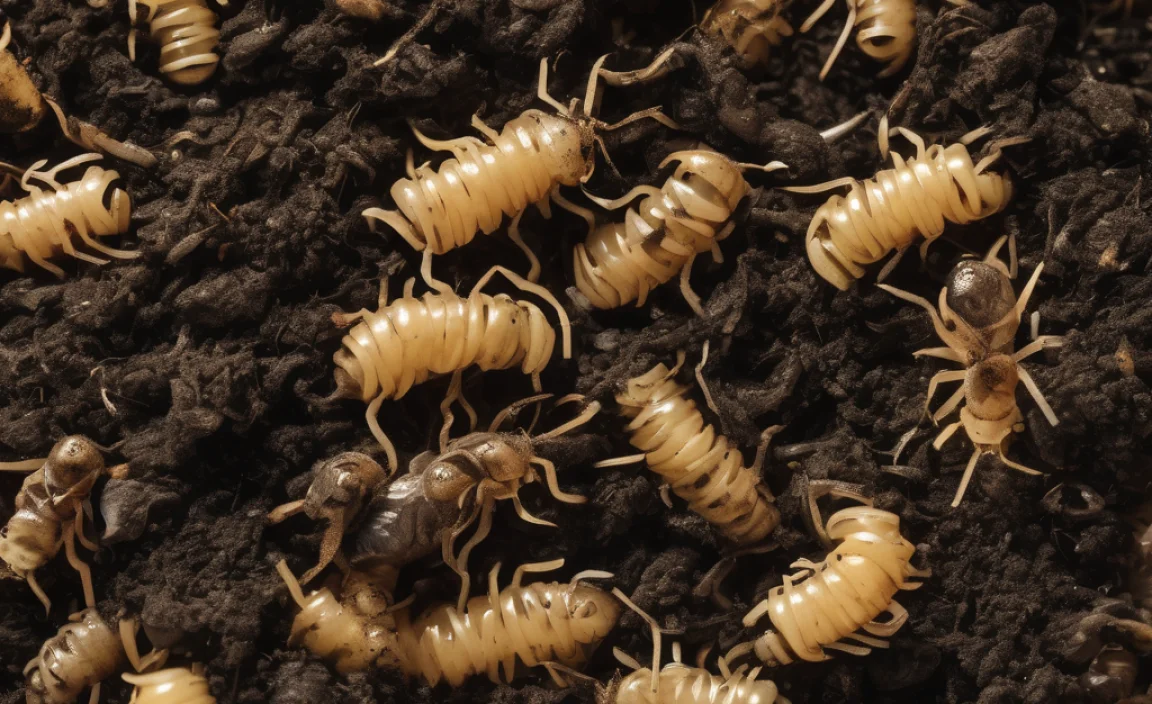
This is a super common question, and the short answer is: not necessarily! Maggots are actually quite helpful in the composting process. They are voracious eaters and help break down organic matter very quickly. In many “hot composting” systems designed to break down waste rapidly, maggots are even intentionally introduced (think of the black soldier fly larvae method – more on that later!).
However, if you’re seeing a massive swarm, they might be a sign that something is out of balance. A large maggot population can sometimes indicate the pile is too wet, too rich in certain nitrogen-heavy materials (like just food scraps), or not getting enough air. It can also lead to smells that might not be neighbor-friendly. So, while not inherently “bad,” a maggot infestation is a signal to check your compost’s health.
When Maggots Signal a Problem
- Overwhelming Numbers: If it looks like your compost is teeming with maggots to the point where they’re almost all you can see.
- Unpleasant Odors: While compost can have an earthy smell, a strong, putrid odor often accompanies an imbalanced, maggot-heavy pile.
- Attracting Other Pests: Maggots can attract larger pests like rodents or other unwanted insects.
How to Fix Compost Has Maggots: Your Step-by-Step Guide
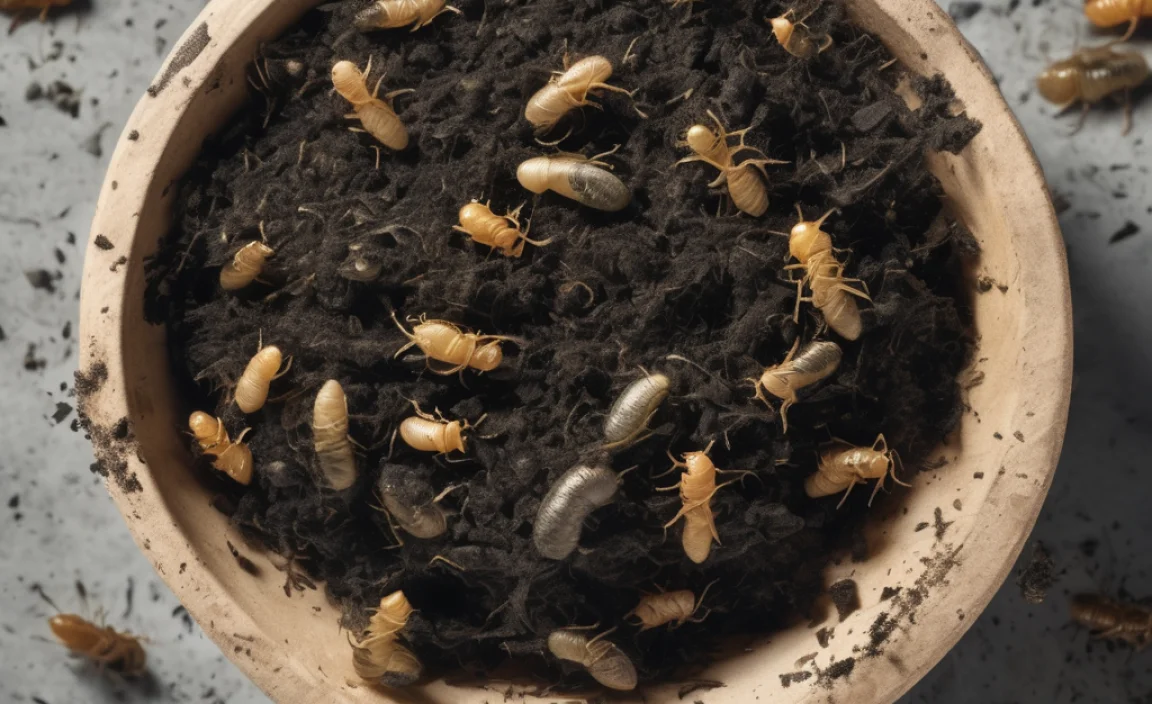
Alright, let’s get down to business and tackle those maggots! These steps are designed to be easy to follow, even if this is your first time dealing with compost critters.
Step 1: Assess the Situation
First off, take a deep breath and look closely. Are these tiny, white, wriggling larvae? Or are they something else? Most likely, they are indeed fly larvae. How many are there? A few scattered ones are fine. If they’re everywhere, it’s time for action.
Also, consider what you’ve been adding to the bin lately. Lots of fresh fruit GZPs? Kitchen scraps without much “brown” material to balance them? That’s often the clue.
Step 2: Cover Up Exposed Food Scraps
Flies lay their eggs on exposed food waste. The easiest way to deter them is to make sure all your new food scraps are buried in the compost. Each time you add kitchen scraps, follow up with a layer of “brown” materials like dry leaves, shredded cardboard, or straw. This “no-see-um” layer is crucial.
Pro Tip: Think of it like tucking those food scraps into bed. You want them covered with a cozy blanket of carbon-rich browns!
Step 3: Balance Your Greens and Browns
A compost pile needs a good mix of nitrogen-rich “green” materials (like kitchen scraps, grass clippings) and carbon-rich “brown” materials (like dry leaves, shredded paper/cardboard, straw). Too many greens and not enough browns overload the pile with nitrogen and moisture, creating an ideal environment for maggots and potential odors. Too many browns can slow down decomposition.
A good rule of thumb is to aim for roughly a 2:1 or 3:1 ratio of browns to greens by volume. If you see a lot of maggots, it’s a strong sign you need more browns.
What are Greens and Browns?
| Green / Nitrogen-Rich Materials | Brown / Carbon-Rich Materials |
|---|---|
| Fruit and vegetable scraps | Dry leaves |
| Coffee grounds and tea bags | Shredded newspaper or cardboard (uncoated) |
| Fresh grass clippings | Straw or hay |
| Plant trimmings (non-diseased) | Wood chips or sawdust (in moderation) |
| Manure (from herbivores) | Eggshells (crushed) |
Step 4: Improve Aeration
Maggots thrive in damp, stagnant conditions. Turning your compost pile regularly with a pitchfork or compost aerator helps introduce oxygen, which is vital for the composting microbes and discourages fly breeding. It also helps to distribute moisture and heat throughout the pile.
How often? Aim to turn your compost at least once every week or two. If your pile is very active or has a maggot issue, turning it more frequently can really help.
External Resource: For more on how aeration works and why it’s important, check out the EPA’s composting guidelines (PDF download), which offer a great overview of composting science.
Step 5: Manage Moisture Levels
A compost pile should feel like a damp, wrung-out sponge – moist, but not soggy. If your compost is too wet, maggots will love it. If it’s too dry, decomposition will slow to a crawl. If you have maggots, chances are your pile is too wet.
- If too wet: Add more brown materials (like dry leaves, shredded cardboard) and turn the pile to help it dry out. Make sure your bin has good drainage.
- If too dry: Add some water. Turn the pile to distribute the moisture evenly. You can also add more green materials.
Step 6: Consider a Different Composting Method (Optional)
If you’re consistently struggling with flies and maggots in a traditional bin, you might consider a different approach. One popular and very effective method is using black soldier fly larvae (BSFL).
BSFL are different from common housefly larvae. They are incredibly efficient at consuming food waste and don’t typically hang around once they’ve eaten their fill. The larvae themselves are also a valuable high-protein food source for chickens, fish, or reptiles. You can buy BSFL bins or even build your own. They thrive in moist conditions and, once established, can outcompete houseflies, often eliminating the maggot problem you might be experiencing.
Benefits of BSFL:
- Extremely fast composting of food scraps
- Larvae are self-harvesting
- Much less attractive to common house flies
- Produces excellent fertilizer
Step 7: Adding More “Hot” Materials (Advanced, Use with Caution)
Sometimes, a cooler compost pile is more inviting to flies. Adding a layer of “hot” composting materials can help raise the internal temperature of the pile, deterring flies and accelerating decomposition. Examples include:
- Fresh grass clippings (in moderation, as they’re “greens”)
- Manure from herbivorous animals (e.g., chicken, rabbit, cow)
- Green, actively growing plant trimmings
After adding these, be sure to cover them with browns and turn the pile thoroughly. A hot compost pile can reach temperatures of 130-160°F (54-71°C), which is too hot for most fly eggs and larvae to survive.
Quick Summary: Fixing Those Pesky Maggots
Don’t let maggots in your compost bin get you down! Here’s a quick rundown of how to get your composting back on track:
- Cover Up: Always bury new food scraps with browns.
- Balance Act: Add more brown materials (leaves, cardboard) to balance your greens.
- Turn It: Aerate your compost pile frequently to introduce oxygen.
- Manage Moisture: Ensure your compost is damp, not soggy. Add browns if too wet.
- Consider BSFL: Black soldier fly larvae can be an excellent solution for food waste.
What NOT to Do When You Find Maggots
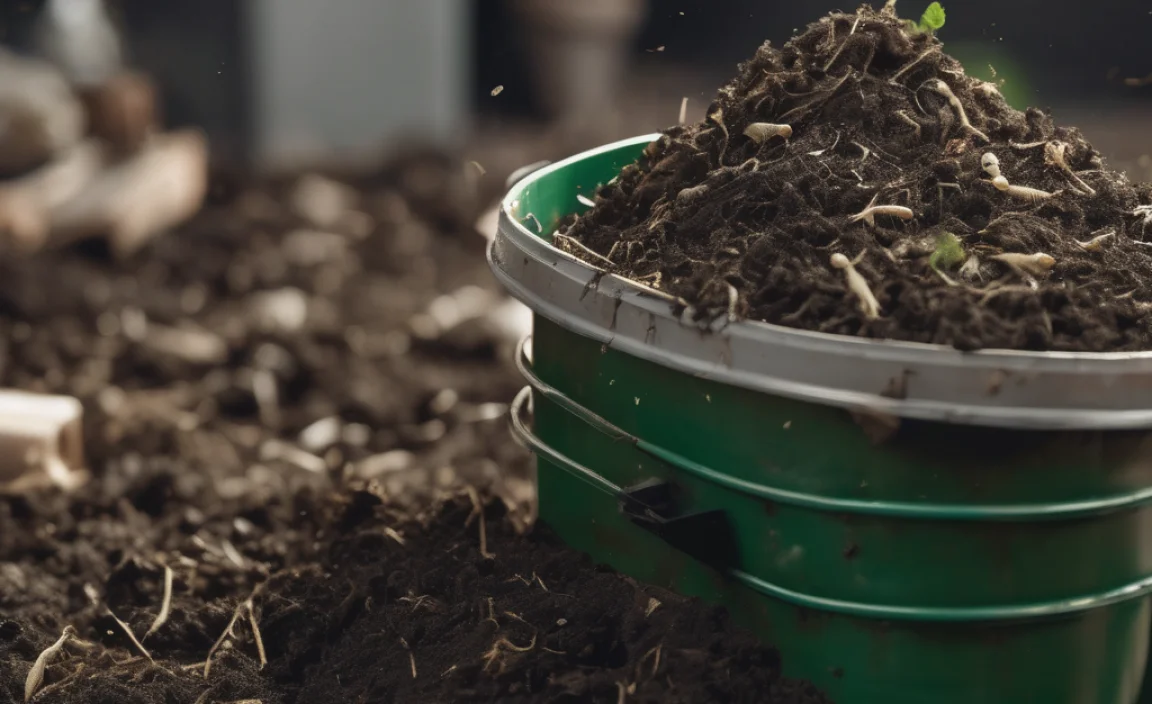
It’s easy to get flustered, but some common reactions can actually make things worse.
- Don’t Panic and Remove Everything: Maggots are part of the process. Removing them manually is often futile and disruptive to beneficial microbes.
- Don’t Add Toxic Chemicals: Never use pesticides or harsh chemicals in your compost. You’ll kill the beneficial microbes and bacteria needed for decomposition, and the chemicals can end up in your garden.
- Don’t Stop Composting: The goal is to manage the situation, not abandon your efforts. Compost is too valuable for the garden!
- Don’t Leave Food Scraps Exposed: Always remember to cover your additions.
Choosing the Right Compost Bin for Maggot Prevention
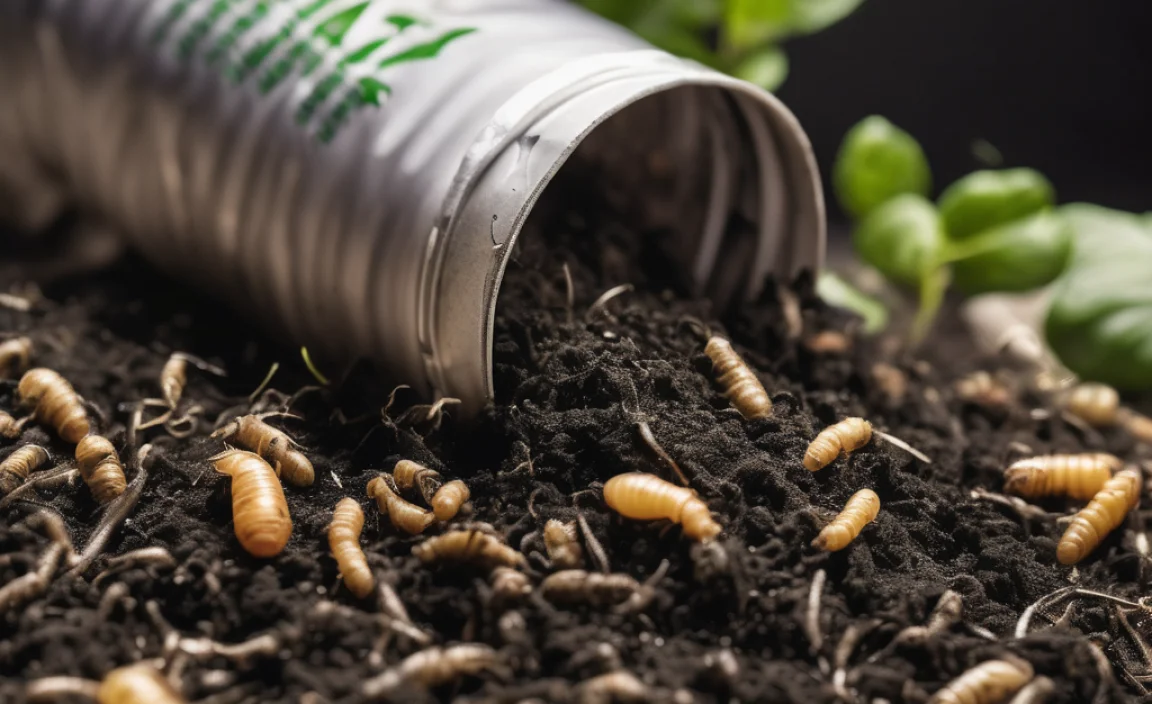
The type of compost bin you use can play a role in how easily flies and maggots become an issue. While maggots can appear in any bin, some designs make it easier to manage them.
Best Bin Types for Maggot Prevention
- Enclosed Bins (Tumblers and Stationary Bins): These bins have lids and solid sides, which act as a physical barrier against adult flies looking to lay eggs on exposed materials. Tumblers also offer easy aeration. Look for bins with tight-fitting lids.
- Worm Bins (Vermicomposting): While not technically for maggots in the same way, worm bins are an excellent alternative for composting kitchen scraps indoors or on a balcony. Red wiggler worms consume food waste efficiently, and the enclosed nature of worm bins is generally not attractive to common flies.
- Black Soldier Fly Larvae Bins: As mentioned, these systems are designed to house BSFL, which are excellent at composting and deterring typical house flies.
Bins That Might Be More Prone
- Open Piles: While great for large volumes, open compost piles offer no barrier against flies. They require diligent management of covering green materials.
- Bins with Large Gaps or Poorly Fitting Lids: Any openings can allow flies easy access.
When selecting a bin, prioritize one that is well-enclosed and allows for good aeration and moisture control. For a beginner, a stationary enclosed bin is often a great starting point.
The Life Cycle of a Fly and Your Compost
Understanding the fly life cycle can help you see why certain actions are more effective. A typical housefly life cycle involves four stages:
- Egg: Flies lay tiny white eggs, often in clusters, on moist organic matter. This is where your compost comes in!
- Larva (Maggot): The egg hatches into a wriggling, legless larva. This stage is all about eating and growing. This is what you’re seeing!
- Pupa: The maggot finds a drier spot (often at the edge of the compost or in drier material) and forms a hard shell around itself. Inside, it transforms into a fly.
- Adult Fly: The adult fly emerges, mates, and the cycle begins again.
Key Takeaway for Composting: To break the cycle, you need to make your compost bin less attractive for egg-laying (cover food scraps), less habitable for larvae (manage moisture, aerate), and discourage pupation (keep things actively composting, rather than leaving dry, stagnant zones). If your compost pile gets hot enough (130°F+), it can kill eggs and larvae directly. This is a hallmark of efficient hot composting.
Conclusion
Dealing with maggots in your compost bin might seem daunting at first, but it’s a common hurdle that many composters face. Remember, seeing a few wrigglers is often a sign of a healthy, active ecosystem at work. By understanding what attracts them and implementing simple adjustments like covering your food scraps, balancing your greens and browns, and ensuring good aeration and moisture levels, you can easily manage and even prevent maggot infestations.
Your compost pile is a valuable resource for nourishing your garden, and a little bit of know-how goes a long way. Don’t be discouraged if you encounter critters; see it
Frequently Asked Questions (FAQ) About Compost Maggots
Here are some common questions beginners have about maggots in their compost.
Q1: Are the maggots I see black soldier fly larvae or housefly larvae?
A: Housefly maggots are typically smaller, whiter, and wriggle intensely. Black soldier fly larvae (BSFL) are larger, darker (often brownish or almost black when mature), and have a more segmented appearance. BSFL are excellent composters and usually not a problem; housefly maggots are the ones that can signal an imbalance.
Q2: Can I still use compost that had maggots?
A: Absolutely! Once you’ve addressed the imbalance that attracted them (by covering food, adding browns, and aerating), the finished compost is perfectly safe and beneficial for your garden. The maggots themselves are just a sign of active decomposition.
Q3: How do I prevent flies from getting to my compost bin in the first place?
A: The best prevention is to always bury food scraps under a layer of brown materials. Using a compost bin with a secure lid also creates a strong physical barrier. Regularly turning and maintaining the right moisture balance will also make your pile less appealing to flies.
Q4: I’m really grossed out by maggots. Is there a way to compost without ever seeing them?
A: While complete eradication is tough, especially with traditional bins during warmer months, you can minimize sightings. Enclosed bins, diligent covering of food scraps, maintaining a healthy carbon-to-nitrogen ratio, and regular aeration are key. For a more controlled environment, consider vermicomposting (worm bins) or a dedicated black soldier fly bin system.
Q5: Will the maggots kill my plants if I use the compost?
A: No, the maggots themselves will not harm your plants. They are decomposers, not plant pests. Once they have finished their lifecycle and the composting process is complete, the resulting compost is rich in nutrients and beneficial for soil health.
Q6: What if I accidentally put meat or dairy in my compost and now have maggots?
A: While many composters avoid meat and dairy due to attracting pests (including maggots and rodents) and potential odors, if you’ve done so and have maggots, follow the steps above: bury the material completely with browns, ensure good aeration, and manage moisture. A hot compost pile (130F°+) is most likely to break down these materials before they become a significant issue, but it can take time and effort to reach that temperature.
Q7: How long do maggots live?
A: The maggot stage typically lasts from a few days to a couple of weeks, depending on temperature and food availability. After that, they pupate and then emerge as adult flies to start the cycle anew. By managing your compost’s environment, you can disrupt this lifecycle quickly.
.lwrp.link-whisper-related-posts{
margin-top: 40px;
margin-bottom: 30px;
}
.lwrp .lwrp-title{
}.lwrp .lwrp-description{
}
.lwrp .lwrp-list-container{
}
.lwrp .lwrp-list-multi-container{
display: flex;
}
.lwrp .lwrp-list-double{
width: 48%;
}
.lwrp .lwrp-list-triple{
width: 32%;
}
.lwrp .lwrp-list-row-container{
display: flex;
justify-content: space-between;
}
.lwrp .lwrp-list-row-container .lwrp-list-item{
width: calc(25% – 20px);
}
.lwrp .lwrp-list-item:not(.lwrp-no-posts-message-item){
max-width: 150px;
}
.lwrp .lwrp-list-item img{
max-width: 100%;
height: auto;
object-fit: cover;
aspect-ratio: 1 / 1;
}
.lwrp .lwrp-list-item.lwrp-empty-list-item{
background: initial !important;
}
.lwrp .lwrp-list-item .lwrp-list-link .lwrp-list-link-title-text,
.lwrp .lwrp-list-item .lwrp-list-no-posts-message{
}@media screen and (max-width: 480px) {
.lwrp.link-whisper-related-posts{
}
.lwrp .lwrp-title{
}.lwrp .lwrp-description{
}
.lwrp .lwrp-list-multi-container{
flex-direction: column;
}
.lwrp .lwrp-list-multi-container ul.lwrp-list{
margin-top: 0px;
margin-bottom: 0px;
padding-top: 0px;
padding-bottom: 0px;
}
.lwrp .lwrp-list-double,
.lwrp .lwrp-list-triple{
width: 100%;
}
.lwrp .lwrp-list-row-container{
justify-content: initial;
flex-direction: column;
}
.lwrp .lwrp-list-row-container .lwrp-list-item{
width: 100%;
}
.lwrp .lwrp-list-item:not(.lwrp-no-posts-message-item){
max-width: initial;
}
.lwrp .lwrp-list-item .lwrp-list-link .lwrp-list-link-title-text,
.lwrp .lwrp-list-item .lwrp-list-no-posts-message{
};
}

I am passionate about home engineering. I specialize in designing, installing, and maintaining heating, ventilation, and air conditioning systems. My goal is to help people stay comfortable in their homes all year long.

